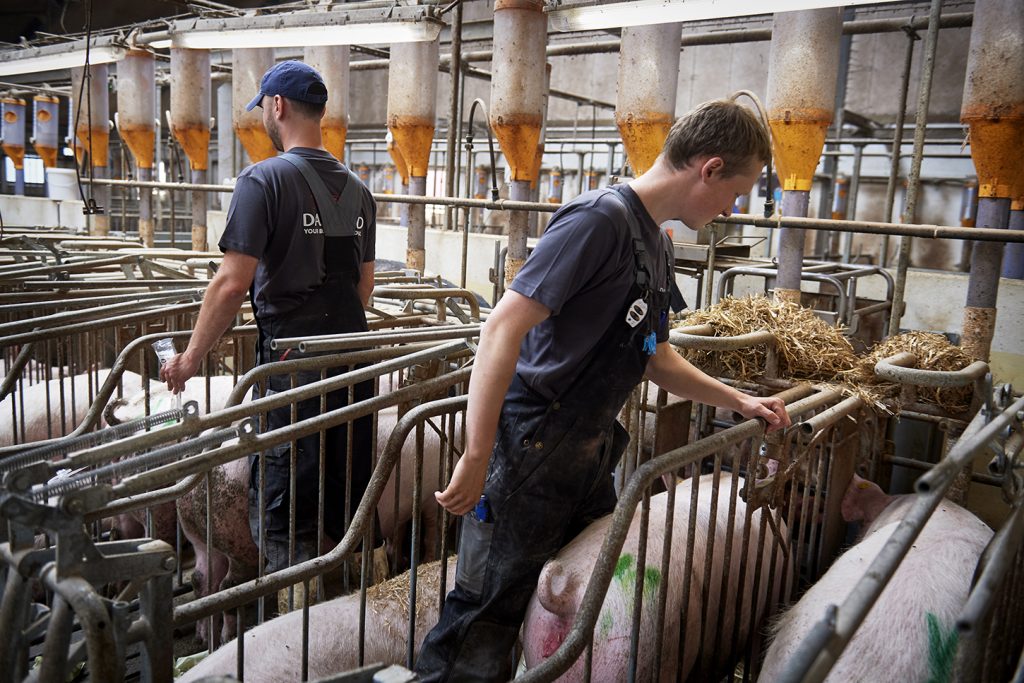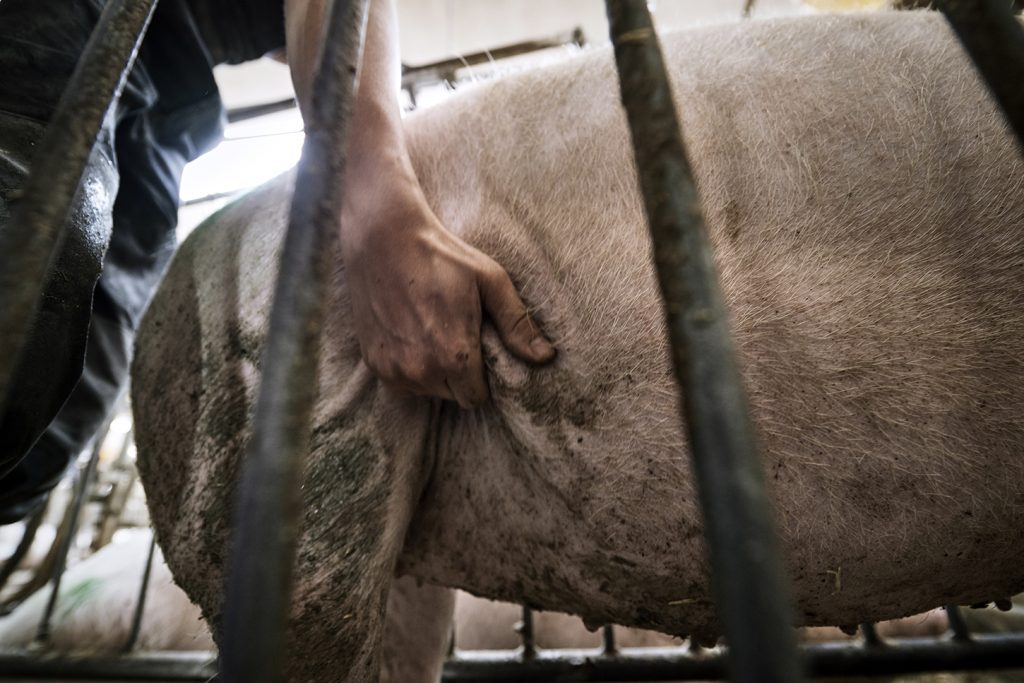Mating Unit
To lay the foundation for a productive life in the short and long term, gilts should be mated for the first time when they are in their second heat, when they weigh 150-165 kg, are 210-230 days old and have a backfat thickness of 13-15 mm. In general, the goal should be sows with an average body condition at all times, in order to maximise productivity.
Body condition scores at the time of mating:

|
|
|
Backfat measurements give a clear image of the gilts’ fat deposit and future reproduction capability. If you want to achieve a low return rate and large litters, you need a set strategy that places a systematic focus on semen handling, heat stimulation and insemination technique for both sows and gilts.
Light
The recommended minimum light levels are 100 lux at gilt eye level 16 hours a day. Make sure all light sources are clean and produce the recommended amount of light. Be aware of any dark corners in the gilt units. Natural light will produce a high amount of lux, but it is very sensitive to dirt on walls and windows, therefore it is a good idea to keep walls clean and paint them white.
|
|
|
Heat observation and registering first heat
- When the gilts are 28 weeks old, start introducing a teaser boar on a daily basis

- When the first heat is detected, make sure you mark which gilts are in heat

- Note each gilt’s ID number and register the date or week number of the first heat

- Once the first heat is registered, you can track the gilt’s 21-day oestrous cycle
Registering the first heat on a regular basis is a good tool for deciding which gilts to inseminate when over the course of the next three weeks. It also gives you a good overview of the number of replacement gilts, helping you select among the older sows from the farrowing section. At this point, you can decide which sows to replace and which to return to the mating unit. This will help you keep the sizes of groups in the mating unit uniform.
Signs of gilts or sows in heat
- Swelling of the vulva
 |
 |
- Reduced appetite
- Increased activity in the pens
- Standing heat
|
|
|
Heat observation and heat stimulation
Carry out heat observation once or twice a day so you are sure all sows and gilts have been checked.
The purpose of heat stimulation is to identify which sows and gilts are in heat. It also increases the production of the hormone oxytocin, which triggers a strong heat, affects semen transport in the uterus and, ultimately, influences the conception rate.
When you are ready to start insemination, it is important to stimulate the sows by imitating the boar. Follow our five-point plan below. Diverging from it or interrupting it can have a negative effect on hormone production, so follow it as closely as you can. Carry out each point of stimulation continuously for at least one minute. Start with the sows which show the strongest signs of heat:
5-Point Plan:
- Push with a fist or knee to the flank

- Grab and lift the groin and stroke the udder

- Push with a clenched fist under the vulva
 |
 |
- Grip and massage the corners of the sows’ hips

- Perform a backpressure test (riding test) to check whether the gilt willingly puts up with you sitting on top of her, moving back and forth

If the sow or gilt does not show any signs of heat, you could try using a different teaser boar or moving the animal into another group to trigger heat.
Mating strategy
Gilts
- Gilts should be mated in their second heat when they weigh 150-165 kg, are 210-230 days old and have a backfat thickness of 13-15 mm.

- Gilts should be mated when standing heat has been detected and repeated after 12 hours
- We recommend gilts and sows have nose-to-nose contact with a teaser boar at mating- switch boars from time to time

- Wait at least one hour after the last feeding before starting the mating process
- Be calm around the animals during mating – avoid causing any unnecessary stress
- After mating, leave the gilts in stress-free surroundings- the gilts should not be moved or re-grouped in the first 5 to 7 hours after insemination
Sows
- Sows should be mated at first standing heat and again after 24 hours
It is important to focus on when the sows come into heat after weaning. If a sow shows heat on day three after weaning, she will not ovulate until around 30 hours after the first standing heat (early sows). Whereas a sow which comes into heat on day six after weaning can ovulate shortly after the first standing heat (late sows).

This means it can be an advantage to adjust the insemination intervals for the sows according to the expected time of heat after weaning- late sows in particular should be in focus.
The recommended mating strategy for early and late sows is as follows:
- Standing heat on day three: First insemination in the afternoon on day four and again 24 hours later.
- Standing heat on day four: First insemination in the morning on day five and again 24 hours later.
- Standing heat on day five: First insemination in the afternoon on day five and again 24 hours later.
- Standing heat after day five: First insemination when standing heat is found and again 12 hours later.

The heat cycle for a sow is 40 to 60 minutes. In the first 20 minutes, the sow will show a strong heat- during the following 20 to 30 minutes it will be difficult to stimulate the sow to a standing heat. It is for this reason that it is important not to stimulate more sows than can be mated within 15 to 20 minutes.
Boar contact
The use of a teaser boar is a very efficient way to heat stimulate sows and gilts, but it only works if the boar is introduced with an element of surprise. If the boar is housed near the sows, try taking him away the day before you plan to introduce him. On the day, place the boar in front of the sows which are to be mated. The sows should be able to have nose-to-nose contact with the boars. Don’t let the boars have contact with more than five or six gilts/sows at a time, and definitely not more sows or gilts than it is possible to inseminate in 15 to 20 minutes.
|
|
|
Focus on feeding before mating
Gilts
- Should be mated in the second or third heat – optimum mating time can be found from the registration of the first heat
- Optimum weight at mating is 150-165 kg – correct weight is more important than correct age
Sows
- After weaning, the feed allowance is set to 4.5 – 5.0 kg per day
It is important that the sows and gilts eat a full ration at each feeding so that each new ration is all fresh feed.
It is also important that the animals do not stop eating – try and keep them going.
After mating, the feed allowance should be lowered to around 2.2 – 2.4 kg per day for gilts, as it has been shown that litter size and farrowing rate can be negatively affected if the feed allowance is too high during the implantation period.
Insemination technique
Before insemination, make sure the sows and the boar are active with nose-to-nose contact.
Use paper to clean dirt from the vulva- this is important to reduce the risk of infection in the uterus.

Gently part the labia (lips of the vulva). Insert the catheter into the vulva and gently push it forward towards the upper part of the reproductive tract to avoid hurting the urethra. Before insertion, make sure the head of the catheter is clean and sterile.
 |
 |
When you feel a firm resistance, pull the catheter slightly, then push the catheter forward a little while twisting it. This will help you make sure that you have placed the catheter correctly in the cervix.

Focus on storage and handling of semen doses before mating
- Take out the semen dose from the transport box immediately after delivery (bought semen)
- Place the semen dose in a climatic chamber at a temperature of 16-18°C

- When mating is due to start, take out the semen doses and place them in an insulated box for transport to the mating unit
 |
 |
- Do not heat the semen dose before use
- Do not expose the semen dose to direct sunlight
- Discard unused semen doses which have been taken out of the insulated box
- Use semen doses diluted with a normal extender within 2½ days after semen collection
- Do not bring more doses than the number of sows which have been registered as being in heat and ready to mate








